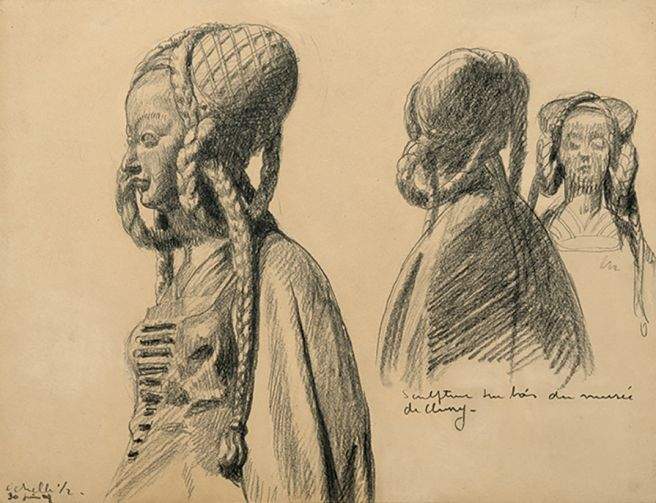Le Corbusier's early drawings displayed in an exhibition in Mendrisio
From September 19, 2020 to January 24, 2021, the USI Architecture Theater in Mendrisio presents the exhibition The Youthful Drawings of Le Corbusier. 1902-1916 promoted by the Teatro dell’architettura Foundation, with the collaboration of theAcademy of Architecture of the University of Italian Switzerland in Mendrisio.
The extensive exhibition, featuring more than eighty previously unpublished original drawings from private and public collections in Switzerland, as well as numerous reproductions of drawings from the Fondation Le Corbusier in Paris, was organized on the occasion of the publication of the first volume of the Catalogue raisonné des dessins de Le Corbusier, edited by Danièle Pauly, published by AAM-Brussels in coedition with the Fondation Le Corbusier and with the contribution of the Fondazione Teatro dell’architettura Mendrisio.
The exhibition, curated by Danièle Pauly, is devoted to the drawings that the young Le Corbusier, pseudonym of Charles-Édouard Jeanneret-Gris (La Chaux-de-Fonds, 1887 - Roquebrune-Cap-Martin, 1965), executed between 1902 and 1916, that is, from theyear of his entry into the School of Applied Arts in La Chaux-de-Fonds, his hometown, to the year preceding his final move to France and the opening of his architectural practice in Paris.
The Theater of Architecture thus welcomes the account of what determined the birth of a vocation that the future architect Le Corbusier thought at first to be that of a painter. A decisive factor in his training will be first and foremost, between 1902 and 1907, his studies in the school of applied arts in watchmaking and interior architecture, influenced by Charles L’Eplattenier, a charismatic teacher and painter influenced by the ideas of John Ruskin and the Arts and Crafts movement. Subsequently, both his experience in Auguste Perret ’s atelier between 1908 and 1909 and his assiduous frequentation of Paris museums, and hisencounter with the architects of the European avant-garde of the early 20th century but also, encouraged by his mentor William Ritter, the study trips between 1907 and 1911, ending with the long journey to the Orient, an experience that profoundly influenced his projects in the years to come.
The works selected for the exhibition are intended to demonstrate the importance that from his earliest days Le Corbusier attached to drawing: a way of approaching reality and an instrument of observation, as, for example, shown by the nature studies he made from 1902 to 1905 during his early school years. Drawing is thus for the young Jeanneret a tool for analysis and research, as seen in the studies made in Parisian museums, or in the early architectural drawings produced La Chaux-de-Fonds between 1905 and 1907. Finally, sketches and drawings are for Le Corbusier both a tool in the service of memory, as evidenced by the numerous sketches in notebooks made during his travels, but also an opportunity for lyrical expression, as evidenced by his watercolors and gouaches of landscapes and female nudes made after his return to Switzerland in 1912.
The exhibition is divided into several sections, starting from his formative school years, characterized by meticulous pencil drawings with naturalistic subjects, small watercolors of landscapes, and decorative studies for handcrafted objects with Art Nouveau motifs, to his travel period with sojourns in European capitals: Italy in 1907 devoted to the study of the Middle Ages and the painting of the Italian “primitive” school; the sojourn in Paris in 1908-1909 with apprenticeships, studies of Notre-Dame and those made in the city’s many museums.
This is followed by the 1910 trip to Germany with a period of practice in the Berlin atelier of Peter Behrens and finally, in 1911, the great initiatory journey to the Orient.
The last section of the exhibition recounts the return to La Chaux-de-Fonds (1912-1916), a period during which Le Corbusier taught, took up architecture, and devoted himself to painting and drawing a series of landscapes, portraits, family scenes, female nudes, and still lifes, which already foreshadow the main themes of the second phase of his production.
For all information you can visit the official website of the University of Lugano.
Pictured: Sculpture on wood from the Museum of Cluny (1909; mina and pencil on paper; Switzerland, Private Collection). Ph. credit Éric Gachet
 |
| Le Corbusier's early drawings displayed in an exhibition in Mendrisio |
Warning: the translation into English of the original Italian article was created using automatic tools. We undertake to review all articles, but we do not guarantee the total absence of inaccuracies in the translation due to the program. You can find the original by clicking on the ITA button. If you find any mistake,please contact us.



























